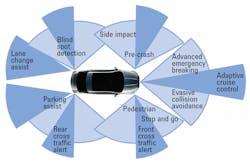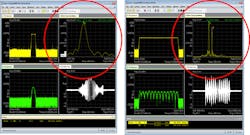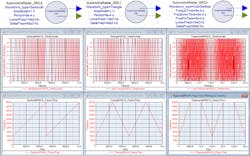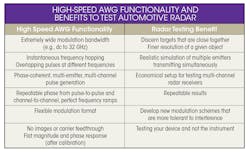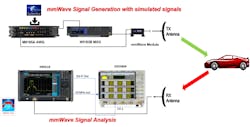Millimeter-Wave Automotive Radar Testing Must be Flexible
Download this article in PDF format.
One of the most ambitious areas of automotive innovation is autonomous driving, where precision sensors provide input to real-time decision-making algorithms. Most autonomous driving strategies use some combination of a sensor set, including optical, LiDAR, and radar systems. Sensors can be deployed at different locations around the vehicle, with each being responsible for providing critical input information to decision-making algorithms.
The radar sensor is tasked with identifying and spatially locating mass-based obstacles. These can include other vehicles, bicyclists, pedestrians, animals, and even fixed obstacles. The key metrics when analyzing the performance of a radar sensor is how reliably it can resolve objects (range resolution), how much it can resolve velocity of objects (velocity resolution), and the size of the antennas that dictate placement.
The first two parameters above are governed by the radar’s bandwidth, while the third is governed by the radar’s center frequency. Understanding the radar’s set of responsibilities in an advanced driver assistance system (ADAS) is key to determining how to measure its performance.
1. Shown are typical automotive mmWave radar applications and mounting locations.
In vehicles, radars are typically integrated in two main locations—either in the four corners or looking out the front of the vehicle (Fig. 1). The corner-looking applications are typically for short-range applications, such as blind-spot detection, lane-change assist, and front/rear collision-warning alert. The front-looking applications are typically mid- to long-range applications, such as emergency braking systems and adaptive high-speed cruise control on highways.
Frequency and Bandwidth Changes Radar Testing
Initial automotive radars were in the 24-GHz band, but were limited to bandwidths of 250 MHz due to worldwide spectrum availability. The narrow bandwidth limited the radar’s ability to resolve objects that were close to one another. Newer 77-GHz radars will offer 1 GHz of bandwidth, while 81-GHz systems will allow up to 4 GHz of bandwidth. These wider bandwidths will dramatically increase range and velocity resolution, and the higher center frequencies enable smaller profile antennas that open up new vehicle installation placement opportunities.
Transitioning from 24- to 81-GHz bandwidths results in 20X better performance in terms of range resolution and accuracy. The improvement in range resolution means that the 75-cm resolution at 24 GHz is as fine as 4 cm in an 81-GHz system, allowing for detection of bicyclists next to cars, people walking with pets, etc.
Test comparisons between 1- and 4-GHz bandwidths highlight the difference (Fig. 2). A 1-GHz bandwidth signal, shown on the left, is not able to distinguish between two side-by-side objects in the same manner as the 4-GHz bandwidth signal, shown on the right. If that were a man and his dog walking closely together and the dog suddenly jumps onto the road, only the 4-GHz bandwidth signal would detect both separately and provide the correct information to the driver or autonomous-vehicle system.
2. Looking at this bandwidth comparison, employing a 4-GHz bandwidth (right) enables two objects that are only 10 cm apart to be separated.
Test Considerations for Advanced Automotive Radars
Developing high-performing millimeter-waveform automotive radar requires minimizing propagation loss, phase noise, I/Q and frequency-response errors, and noise. Testing at mmWave frequencies, especially the 76- to 81-GHz band, demands a sophisticated test solution where the choice of instruments, cables, connectors, and accessories all matter to ensure signal accuracy and repeatability. Important considerations exist in the design, validation, and manufacturing test phases that could skew the outcomes.
Design Simulation Phase
3. These FMCW signals were generated by the Keysight SystemVue W1908 Automotive Radar Library (from left to right: sawtooth, triangle, and custom FMCW waveforms).
Flexible, accurate signal generation is at the heart of good radar system design and test. This starts with an automotive radar simulation library that contains multiple models and reference designs. The library should include comprehensive tools for frequency-modulated-continuous-wave (FMCW) radar waveform generation, signal modulation, antenna modeling, channel simulation, and signal processing. Reference designs, such as multi-target range, speed measurement, and 3D scanning radar using antenna arrays, provide a starting point to implement design ideas into early simulations and prototyping. Figure 3 shows samples of three different types of FMCW signals.
Development Phase
Once a simulated waveform is selected, a developer downloads it to an arbitrary waveform generator (AWG). AWGs are used to generate wide-bandwidth radar signals for automotive radar testing (see table). The signals are upconverted to mmWave frequency bands to verify designs in preparation for real hardware testing. A typical test setup consists of an AWG, a vector signal generator (VSG), and an upconverter to generate an ideal reference signal (replace Tx LO/VCO) plus interference, clutter, and jamming signals (Rx Test).
Wide-bandwidth automotive radar signal analysis includes RF power, spectrum emissions, phase noise, frequency stability, and modulation quality. For this, a complete automotive radar signal-analysis system, such as the setup shown in Figure 4, is needed.
4. This is a complete automotive radar signal-analysis system.
When measuring wide-bandwidth systems, it is vital to have measurement capabilities that go beyond the expected design. For instance, if testing 4-GHz bandwidth signals at 81 GHz, it is recommended to use a signal-analysis system that can analyze frequencies as high as 110 GHz and bandwidths as high as 5 GHz for extra design margin.
The other key metric is sensitivity. A displayed average noise level (DANL) that reaches −150 dBm/Hz allows developers to measure low-level and sensitive radar signals. The Keysight E8740A automotive radar signal-analysis and generation solution performs analysis and generation of automotive radar signals across full frequency ranges for 24-, 77-, and 79-GHz radar. It provides scalable analysis bandwidth that ranges from 2.5 to greater than 5 GHz, depending on test requirements.
Manufacturing
Once a design is complete, efficient and comprehensive test coverage during manufacturing increases reliability and reduces cost. During manufacturing test, the key is to create a scalable, reliable, accurate, and repeatable radar target simulator (RTS) solution.
At a minimum, the RTS should be able to apply time delay, Doppler frequency shift, and attenuation to simulate range, radial velocity, and radar cross-section (size of object) in a simulated test range. To be realistic, the RTS needs to be capable of testing at ranges as close as 1 m and as far as 450 m, and within speeds from zero to ±360 km/hour.
End-to-End Testing for mmWave Automotive Radars
While optimizing all three parts of the development cycle are important, flexibility is the most critical aspect during the development phase. Testing is rarely static during this phase, as developers strive to precisely measure performance in the presence of a variety of realistic noise and jamming conditions—all of which need to be integrated.
Frequency coverage, measurement accuracy, and dynamic range of instruments make a huge difference in measurement efficacy. And most importantly, do not forget to implement a disciplined S-parameter and power calibration process to ensure that measurements remain accurate throughout your design, validation, and production phases.
Jeff Harris is Vice President of Portfolio Marketing at Keysight Technologies.
About the Author
Jeff Harris
Vice President, Global Marketing, Keysight Technologies
Jeff Harris leads global marketing for Keysight Technologies including product marketing, brand, corporate communications, in addition to all of the company’s digital marketing channels. Jeff has led the transformation of Keysight’s global brand, content strategy, and digital channel transformations creating awareness and influencing customer preference. Jeff also drives thought-leadership initiatives to surface stories of how Keysight accelerates innovation and helps customers win in their markets.
As a former product development leader for commercial and government applications at companies like ViaSat, General Atomics, and Lockheed-Martin, Jeff has led first-to-market product introductions across radar, optics and acoustic sensors; surveillance vehicles to drones; and ultra-wideband (UWB) to mobile ad hoc network (MANET) communications.
Jeff holds Bachelor of Science and Master of Science degrees in Electrical Engineering from George Mason University and is an avid follower of technology, always looking for the data in marketing and measuring its impacts.

